New Fast Connection from Split Airport to Bol Starting on 1 June
Something new is on the cards for the very beginning of next month in time for the height of the tourist season for those wanting a direct line from Split Airport to Bol on the nearby island of Brač, the third largest island in Croatia.
As Morski writes on the 17th of May, 2019, as of the 1st of June 2019 to the 15th of September 2019, the new fast-freight company Adriatic Fast Ferries d.o.o. will introduce a fast-freight line four times a day from Split Airport to Bol on the central Dalmatian island of Brač. There will be two direct connections and two lines which will head to Bol via Split's busy ferry port.
The direct connection will take one hour from Split Airport to Bol, and the line which will stop at Split's ferry port will take an hour and twenty minutes. There will be three lines in place from Bol to Split per day, according to a report from the local portal Bol info.
Unlike for other ferries and connections, tickets for this new line can only be purchased online at the ship's website.
The catamaran for this line was built back in 1999 at the FBM Marine Ltd shipyard and was purchased from the English company Red Jet. The catamaran is 33 metres long and has a capacity of 190 passengers.
Make sure to follow our dedicated lifestyle and travel pages for much more.
Split Police to Approve Placement of New Surveillance Cameras
Big Brother may well be watching you in and around the wider Split area as local police approve a significant number of brand new surveillance cameras in numerous locations within that aforementioned area of central Dalmatia in the name of heightened security.
As Poslovni Dnevnik writes on the 17th of May, 2019, the Croatian police in Split-Dalmatia County will issue their approval if all of the necessary conditions for the placement of the new surveillance cameras are met, and if they deem that the setting of the new video surveillance system will positively affect the level of general security of people and property.
The Split Police Administration has stated that approvals have already been issued for the installation of new surveillance cameras in the nearby areas of Trogir and Solin.
As Slobodna Dalmacija reports, as of the beginning of 2019, the Split Police Inspectorate has issued two approvals for the placement of video surveillance systems in Trogir in 23 locations and in Solin in a further 10 locations. Before the new approvals came, Solin had received police approval for three cameras, and this year Solin requested a police review of locations where the administration could set up three times as many such devices.
Should local police give the green light to the new surveillance camera locations and agree that their placement would be beneficial to the area's overall safety and security levels for both people and for property, then all of the approvals will be given. In previous years, licenses were granted to Split for fifteen different locations, Solin received approval for three locations, Makarska got the green light for six locations, Hvar was okayed for twelve locations, Sinj was approved for one and the Lovreć Municipality received approval for four locations.
Make sure to follow our dedicated lifestyle and Total Split pages for much more.
Ultra Europe Announces 15 New Artists Coming to Split this Summer
We’re just two months away from the start of the most anticipated event in the summer season, and with that comes even more great news. Namely, Ultra Europe, which will take place from July 12 to 14 in Split, has announced 15 new performers for the seventh edition of the festival. Thus, festival goers can enjoy Cheat Codes, Steve Aoki, Nicky Romero, Sunnery James & Ryan Marciano, Gud Vibrations, Tchami X Mala, Rezz, Lost Kings and Jeffrey Sutorious.
This year's edition is the most expensive festival lineup in history, and with the arrival of the mega Swedish House Mafia, Ultra Europe will surely mark the 2019 summer season all over Europe.
It's almost impossible to turn on the radio without hearing a tune by Cheat Codes, a trio from Los Angeles, featuring Trevor Dahl, Matthew Russell and Kevin Ford. The group released the song ‘Sex’ in 2016, and the single ‘No Promises’ from 2017, collaborating with American pop star Demi Lovato, reached the top of the charts in the US, UK, and Australia. The group will play their many hits, and especially their currently single ‘Who's Got Your Love’. Another star arrives from Los Angeles, Steve Aoki, who needs no special introduction. This energetic, eccentric, and always entertaining DJ is ready for two crazy hours on the biggest dance floor in Split.
The first lady to play on the grand stage is Rezz, a DJ by the real name Isabelle Rezazadeh. Her debut album 'Insurrection', which was released in 2015, is the next in line to sign a contract with the Deadmau5 'Mau5trap' publishing house. Her second album, 'Mass Manipulation', won the Juno Award for Best Electronic Album in 2018. Rezz is playing at all major world festivals, and this summer will premiere to the Croatian audience. The name Jeffrey Sotorious is already a well-known name on the international EDM scene. He is a performer who has acted under the name Dash Berlin for years, and at the seventh edition of the festival, this talented Dutchman will perform for the first time on his own.
Dutch DJ Nicky Romero is known for his hit ‘Tolouse’, which has almost half a billion views on YouTube, and 'Legacy', 'Symphonica' and 'I Could Be The One', which is a collaboration with Avicii. He cooperated with stars such as Zedd, David Guetta and Calvin Harris, Rihanna and Britney Spears. Sunnery James & Ryan Marciano, two more famous Dutchmen, return to Ultra Europe to the joy of many fans. This attractive duo is known for joining elements of house, tribal, techno, electro and Latino rhythms into contagious hits. They recently released the single ‘Shameless’, though we can’t forget the hit ‘You Are’, a collaboration with Armin van Buuren, Badman, Born Again and many others.
There are even more names to perform on the attractive RESTISTANCE stage, a tech, house and underground concept that has attracted more and more fans in recent years around the world. Split will host some of the most prestigious techno performers in electronic music such as Nic Fanciulli, Patrice Baumel, Dubfire and Jon Rundell. DJ and producer Sasha is coming to Poljud, best known for his live performances and collaboration with British DJ John Digweed, with which he acts under the name Sasha & John Digweed. In 2000, he was chosen as the best DJ in the world, and is known for his heavier rhythms. The Art Department is another exciting name on this year's line-up. The Canadian musicians Jonny Whitenapor and Kenny Glasgow have teamed up to become one of the electronic success stories of the world. The Guardian, Rolling Stone, Billboard, Vogue, ID, Nylon, and Vibe Magazine have written about this duo as a phenomenon that can stand beside Daft Punk.
Ultra Europe in Split will bring the already announced Above & Beyond, Adam Beyer, Afrojack, Alesso, Armin van Buuren, Carl Cox, The Chainsmokers, David Guetta, DJ Snake, Jamie Jones, Joseph Capriati, Maceo Plex, Marco Carola, Richie Hawtin, and Swedish House Mafia.
Furthermore, this year’s Ultra Beach in the Amphora Hvar Grand Beach Resort on the island of Hvar will feature the most vibrant and world-renowned Martin Solveig and Jax Jones. The second name on the list is the British duo Sigma, and the names of other performers will be known by the end of May.
Just two days ago, the lineup of the Brač Regatta parties was announced! This island party will feature the popular trio Cheat Codes, as well as the biggest domestic DJ star - the Croatian-Slovenian duo Vanillaz, who will soon appear on the main stage of Ultra Singapore and Ultra Korea.
The Ultra Europe Festival offers electronic music lovers a comprehensive experience of the destination, and this year the entire festival experience will be even better thanks to the festival's partners, including the Croatian National Tourist Board. You can find more information and tickets on the official Ultra Europe website.
DESTINATION ULTRA 2019
11. July - RESISTANCE Opening Party / Giraffe Palm Beach House, Split
12.- 14. July - ULTRA Europe / Poljud, Split
15. July – Regatta Party / 585 Club, Bol, Brač
16. July - ULTRA Beach Hvar / Hotel Amfora Grand Beach Resort, Hvar
16. July - RESISTANCE Hvar, Carpe Diem Beach Club
17. July - RESISTANCE Vis Closing Party / Fort George, Vis
To read more about lifestyle in Croatia, follow TCN’s dedicated page.
JRE Masterclass: An Evening with Chef Vjeko Bašić of Murter's Konoba Boba
On Wednesday, May 15, 2019, TCN was lucky to be a part of one of the eight Jeunes Restaurateurs (JRE) masterclasses.
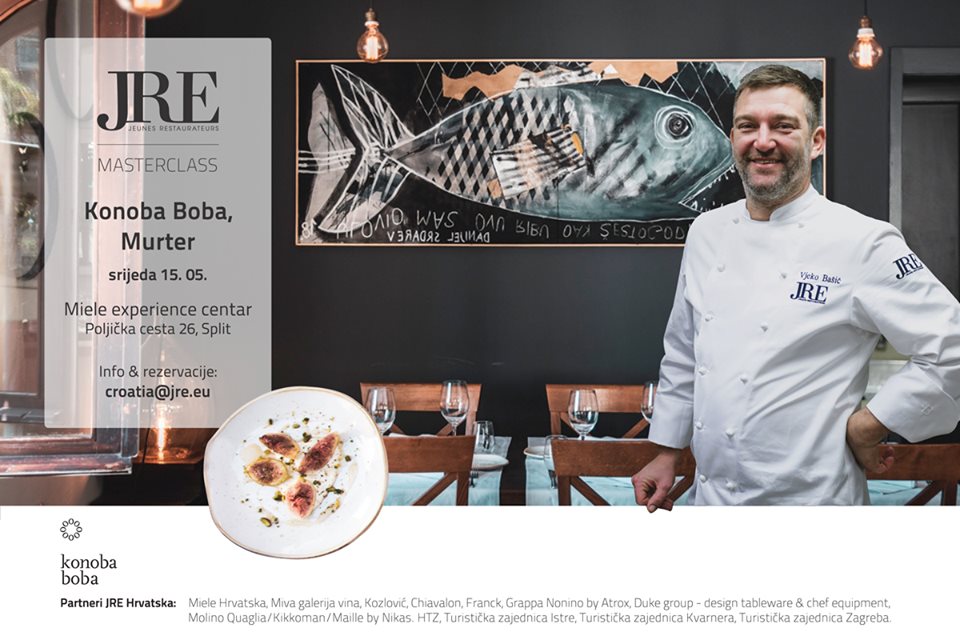
Now, if you aren’t familiar with Jeunes Restaurateurs, allow us to enlighten you.
JRE is an association of the most creative chefs from 16 countries in Europe. In Croatia, JRE boasts 14 restaurants, including San Rocco, Pergola, Marina, Zigante, Monte, Draga di Lovrana, Plavi podrum, Boškinac, Foša, Pelegrini, Dubravkin put, Villa Ariston, Konoba Boba, and Lešić Dimitri.
This association of the most creative gastronomy, founded in 1974, includes around 350 restaurants and 160 hotels in total, spread across 15 countries: Australia, Austria, Belgium, Croatia, Germany, France, Ireland, Italy, Luxembourg, the Netherlands, Poland, Slovenia, Spain, Switzerland, and the United Kingdom.
“JRE chefs combine extraordinary talent, a deep passion for cuisine, a love of local produce, and a strong sense of tradition. Their cooking expertise paired with the outstanding atmosphere of their restaurants offers a truly incredible experience.
JRE membership is open to young restaurateurs and chefs under the age of 42. However, when members reach the age of 50, they are awarded ‘honorary’ status and join JRE’s ‘Table d’Honneur’.
At JRE, everything revolves around sharing, encouraging and inspiring passion and talent for food. Our young chefs show great solidarity with each other and are delighted to exchange their cooking knowledge and expertise. As a guest at a JRE restaurant, there’s no doubt you will reap the benefits of this collective passion,” reads the JRE website, and after attending one of their masterclasses, this became even clearer.
The JRE masterclass held on Wednesday completed the association's masterclasses for the first part of the year. Namely, JRE held two at the Miele in Zagreb and two in Split. Each JRE masterclass is traditionally held at Miele, a high-end German manufacturer of domestic equipment and appliances.
The final masterclass for this half of the year featured chef Vjeko Bašić of Konoba Boba in Murter, a famous restaurant that prides themselves on traditional Kornati cuisine and locally sourced ingredients from the surrounding area. While most masterclasses max out at 8-9 guests, the demand for Vjeko’s culinary skills attracted around 12 curious visitors at Miele in Split.
Bašić began the masterclass with a welcome hors d'oeuvre; a perfect round of homemade (and gluten-free) tapioca bread, topped with fresh anchovies, osmugalj (which is best-translated in English as opposite-leaved saltwort), and dried olive oil, made with a combination of maltodextrin, olive oil, and salt.
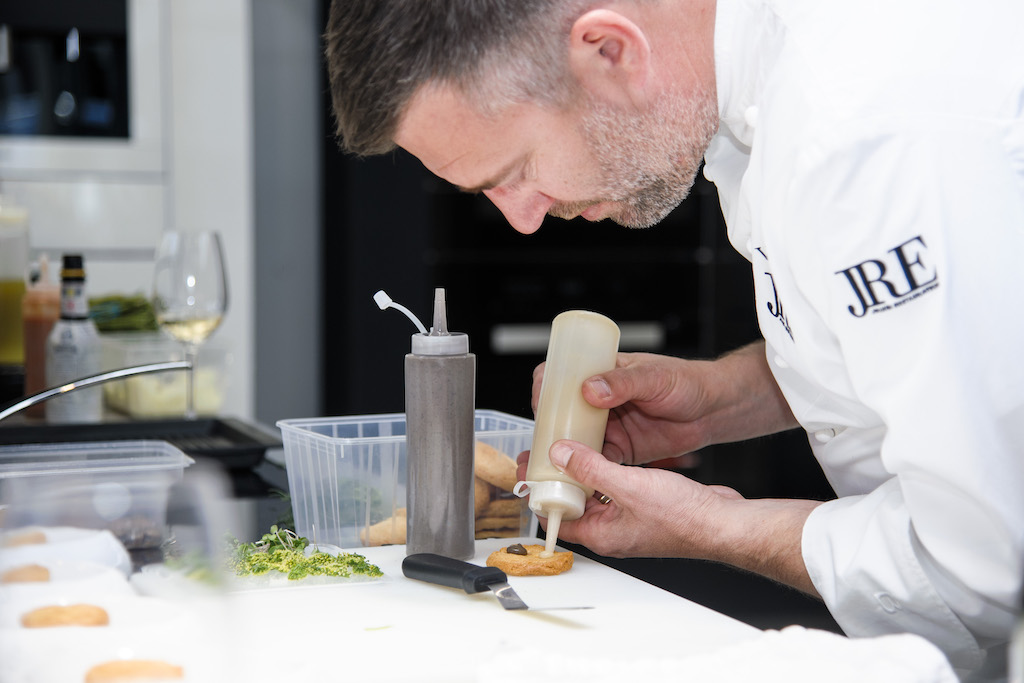
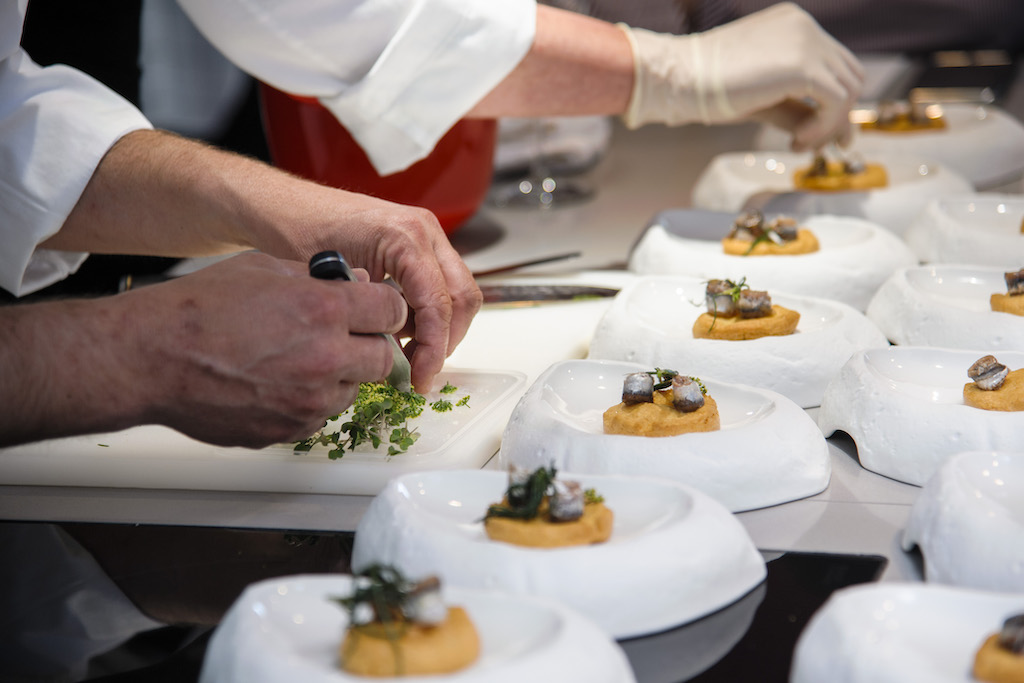
What rounded off the experience even more was that each course was paired with a different Croatian wine, and each serving plate was a unique Miele product.
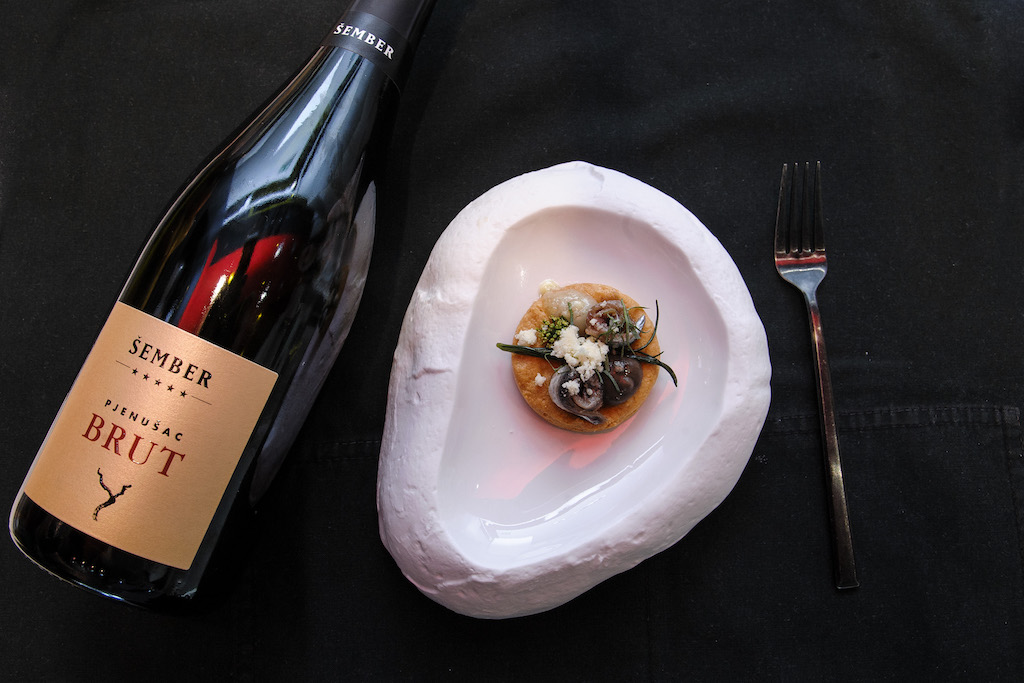
The first - a Pjenušac (sparkling wine) from the Šember winery in Jastrebarsko.
Up next, Bašić filleted a fresh Branzino (or European bass) into thin and delicate pieces for a carpaccio dressed with a lemon gel.
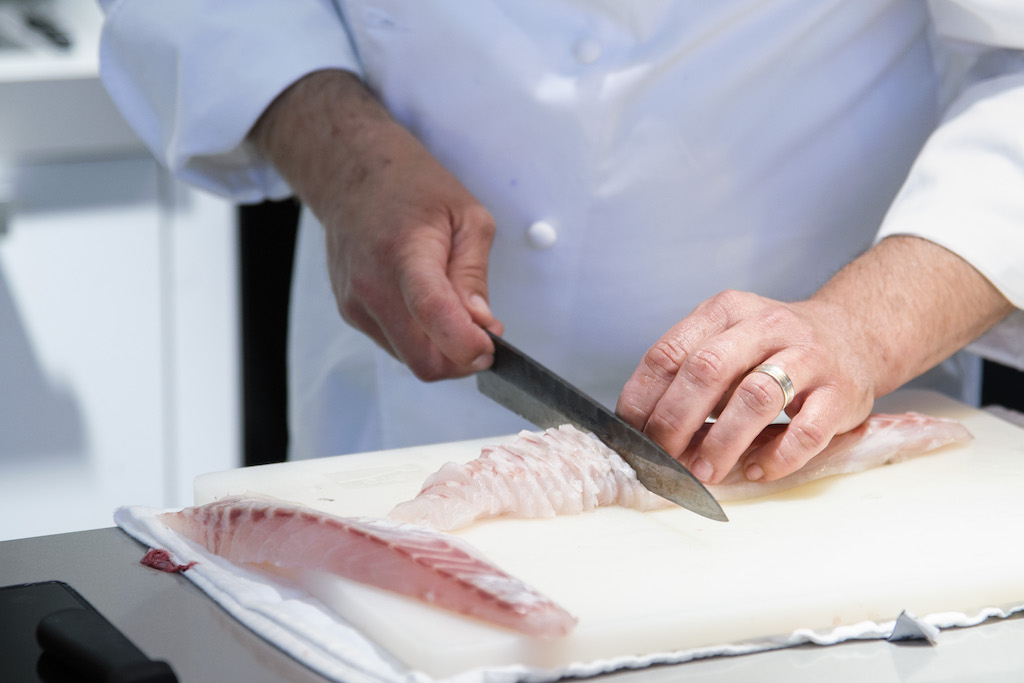
This course was paired with Blend No. 1 from Dvorac Belaj in Istria, a mix of chardonnay and malvazija.
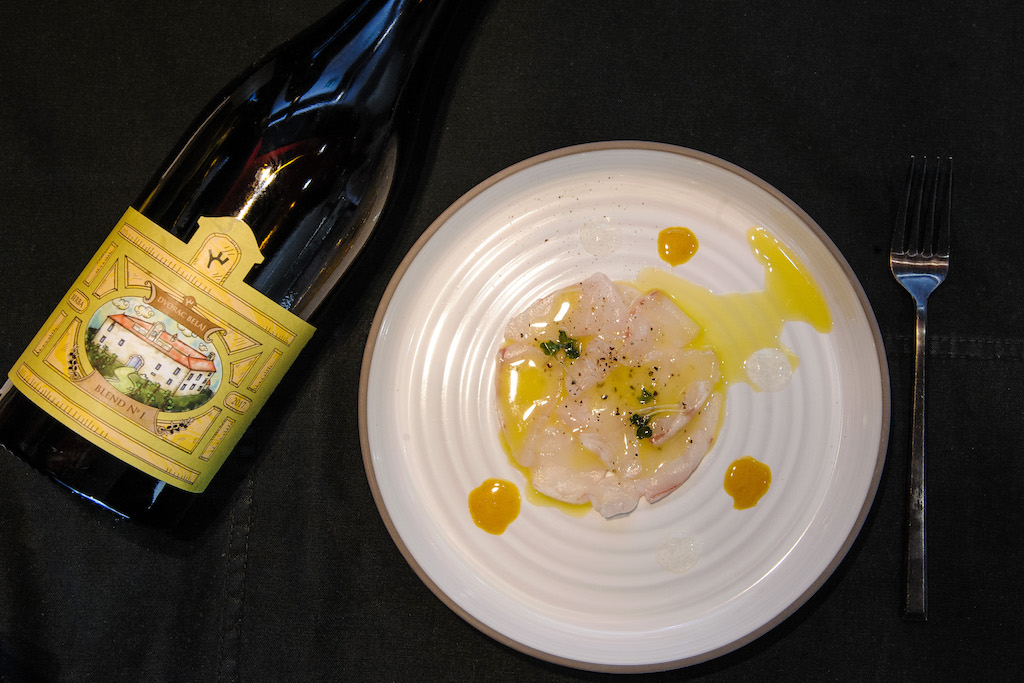
For the main course, Bašić constructed a risotto using the broth of boiled Branzino, the broth of fresh asparagus, which he joked was picked at Krka National Park, white wine, and a bisque made from the heads of scampi, tomatoes, and onions.
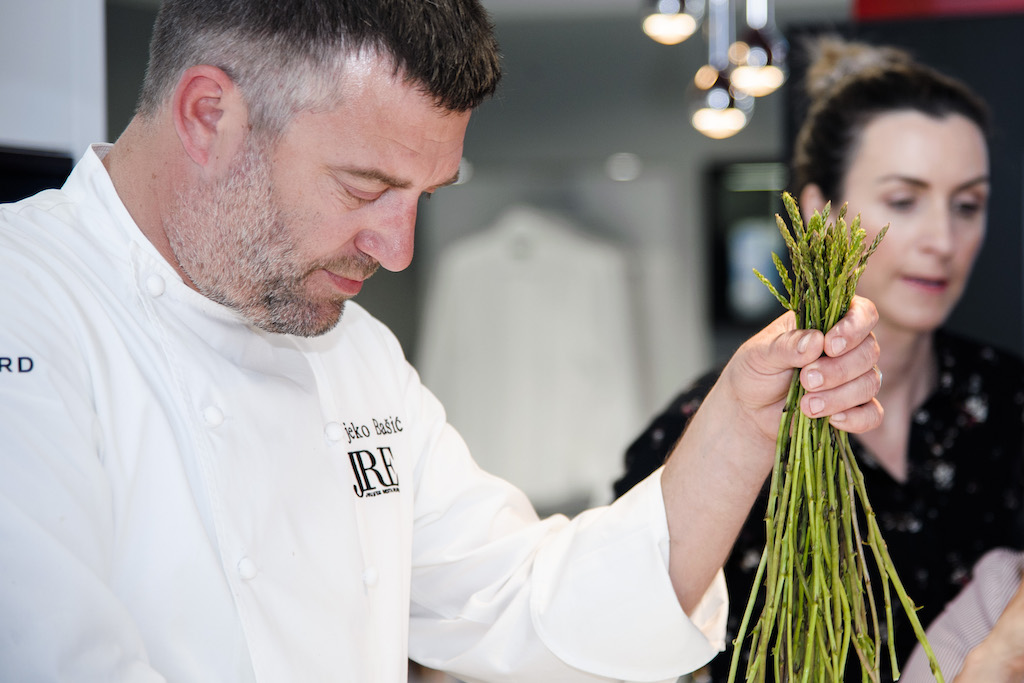
After it was tediously mixed for a solid half hour, the risotto was topped with quickly pan-fried scampi splashed with angostura bitters and an asparagus foam. The third wine pairing was a Sauvignon from the Galić winery in Slavonia.
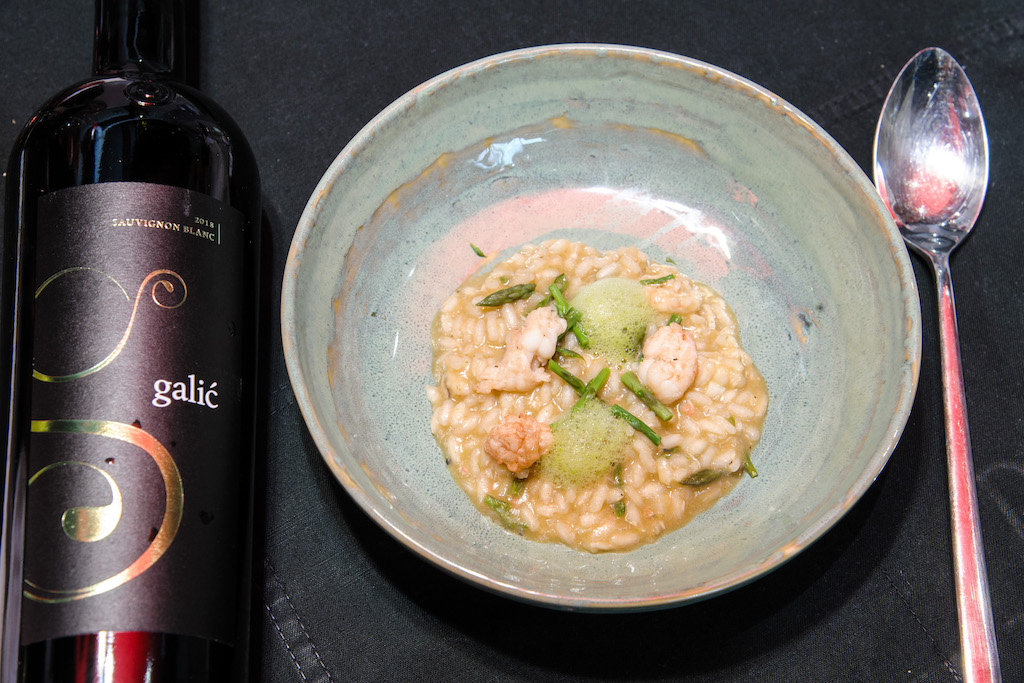
One unique takeaway from the masterclass experience was that JRE makes a limited blend of olive oil with the award-winning Chiavalon from Istria. You can find the oil in JRE restaurants, or, for example, at one of their masterclasses.
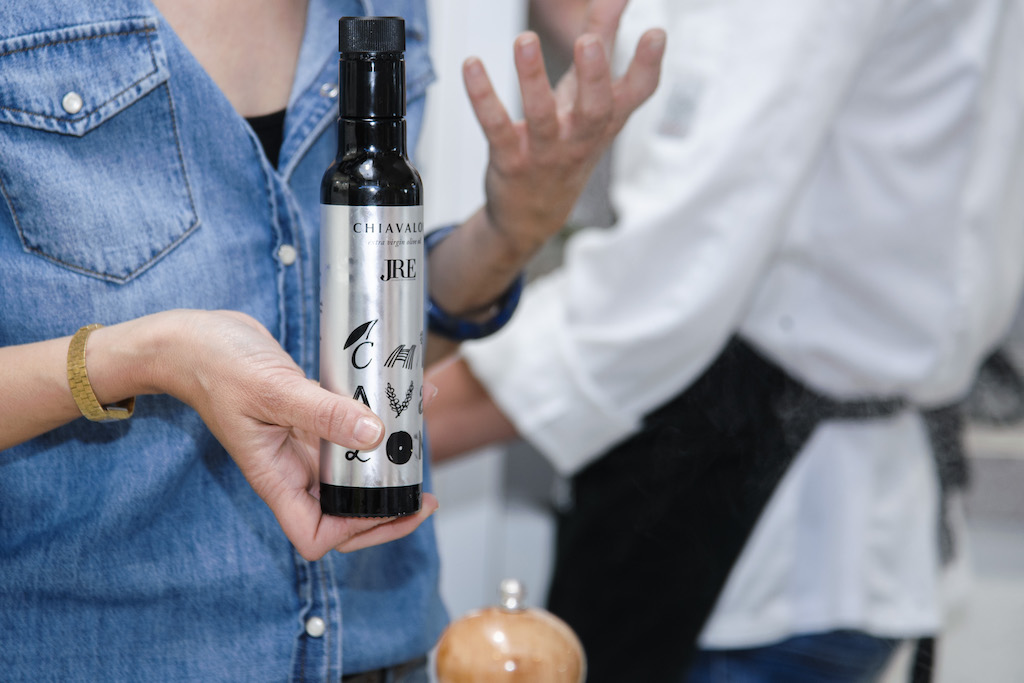
And for dessert? A simple yet decadent lemon cake decorated with lemon curd and almond flour crumble. We ended the evening with a Dolceto by Franc Arman in Istria.
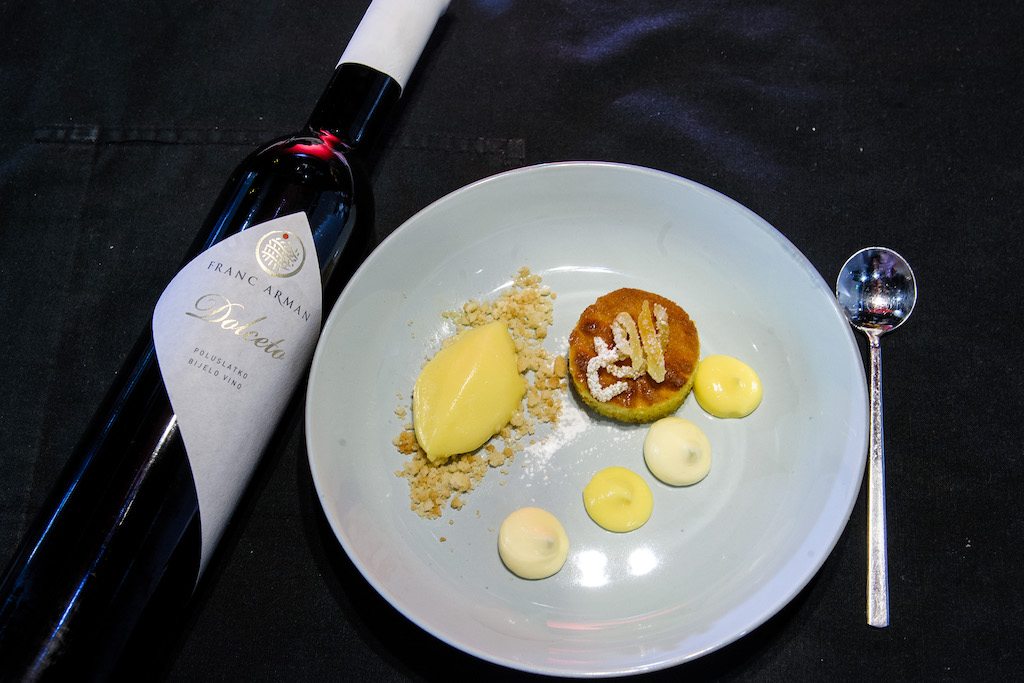
You can find all the photos from the masterclass below.
The JRE masterclasses are a way to bring the chef’s culinary talent and passion for food and local ingredients to an intimate setting of curious and like-minded people. The next four JRE masterclasses will pick up again in October with new JRE chefs. And stay tuned this summer, as JRE has something exciting cooking.
You can read more about the JRE association and sign up for the next masterclass by visiting their website and following them on Facebook.
To read more about lifestyle in Croatia, follow TCN’s dedicated page.
EkoFjera Mediterranean Returns to Prokurative in Split this Weekend
On Friday, May 17 at 9:00 am, Prokurative in Split will host a two-day fair of ecological products titled ‘EkoFjera Mediteran’, organized by the Public Institution for Coordination and Development of the Split-Dalmatia County RERA SD and the Association of Ecological Producers of Dalmatia "DALMACIJA EKO", reports Splitski Dnevnik on May 15, 2019.
EkoFjera will be held for the fourth consecutive year, and each year under a different theme. This year, the theme of the fair aims to promote the Mediterranean diet and way of life, since Ekofjera is held as part of the MD.net project - valorization of the Mediterranean diet as a non-material heritage of UNESCO funded by the European Union through the INTERREG Mediterranean program. One of the most important results of the project is the development of new products based on the Mediterranean diet. Split-Dalmatia County will focus its activities on this segment in the development of products of island secondary school cooperatives.
The organization of EkoFjera Mediteran is just one of the activities of the project that focuses on bringing Mediterranean nutrition closer to school children.
Since its inception in 2016, the fair has been educational and has encouraged the participation of primary and secondary school children from Split-Dalmatia County. This year, the "Mediterranean Ecological Marenada” will be organized for approximately 500 school children of the first grade. School children and their companions will be presented a healthy, ecological version of breakfast as well as the importance of sustainably purchasing and using local foods in their preparation. Several well-known athletes will participate, who will additionally animate their examples of healthy eating for the children.
Ekofjera is the largest ever this year and for the first time has spread its wings internationally. Namely, more than 60 ecological producers from Croatia and Italy will be presented, which is an excellent opportunity for consumers to meet ecologists and establish long-term contacts for purchasing organic food. Particularly interesting is the fact that this year there will be significantly more producers of fresh programs, and ecological fruits and vegetables, which in previous years was deficient.
And strap on your dancing shoes for Friday night, as the jazz and Bossanova band Hot Shots will take the stage - with top quality organic wines, brandies and juices for everyone to enjoy.
To read more about lifestyle in Croatia, follow TCN’s dedicated page.
HNL Round 34 Recap: Osijek Tops Rijeka, Hajduk Moves Closer to Europe
May 16, 2019 - The 34th round of the Croatian First League was held on May 14 and 15, 2019. In one of the few mid-week rounds, we saw Rijeka fall to Osijek, and Hajduk crush the last-placed Rudeš, inching them even closer to securing that sacred 4th European spot.
Without further ado, here is our 34th round recap.
Istra 1961 v. Inter Zaprešić (0:1)
Istra and Inter met in Pula on Tuesday, May 14, 2019, to open the 34th round in front of 488 fans.
The first and only goal of the game was scored by Inter’s Serderov, which gave the away team the 0:1 win.
Istra is currently in 9th place with 22 points, while Inter is in 8th with 31.
Rudeš v. Hajduk (1:4)
Rudeš and Hajduk met on Tuesday, May 14, 2019, at Kranjčevićeva street stadium in front of 738 fans.
Hajduk’s Mijo Caktaš was the first to score with a goal in the 17th minute for 0:1. Caktaš increased Hajduk’s lead to 0:2 with another goal in the 58th minute, though Rudeš was able to come back with one thanks to Lisakovich who scored in the 62nd. Caktaš nailed a hattrick in the 65th minute for 3:1, and Jradi scored one minute later for the final score of 1:4.
Rudeš remains in the last place with 14 points, while Hajduk sits in 4th with 59.
Slaven Belupo v. Lokomotiva (1:1)
Belupo and Lokomotiva met on May 15, 2019, in Koprivnica in front of 315 fans.
While the first half went without goals, it was Belupo to score first thanks to a penalty scored by Mateus for 1:0. Lokomotiva was able to equalize in the 75th minute for 1:1.
Belupo is currently in 7th place with 33 points, while Lokomotiva is in 6th with 49.
Dinamo v. Gorica (3:1)
Dinamo and Gorica met on Wednesday, May 15, 2019, at Maksimir in front of 610 fans.
Dinamo’s Moro scored first in the 17th minute, which was followed by a goal from Olmo in the 21st for 2:0. Gorica did come back with one goal in the 25th thanks to Ndiaye for 2:1 at the half.
After Petković missed a penalty in the 66th minute, it was Leovac to score in the 71st minute for the Dinamo win.
Dinamo has already clinched the title and is in the first place with 86 points, while Gorica is in 5th place with 53.
Osijek v. Rijeka (2:1)
Osijek and Rijeka met on Wednesday, May 15, 2019, to close out the 34th round at City Garden Stadium in front of 2,032 fans.
Rijeka was the first to score thanks to a goal by Colak in the 11th minute, though Osijek’s Marić equalized in the 24th minute for 1:1. Rijeka’s Pavić was sent off the pitch after a double yellow in the 39th minute.
Marić scored again for Rijeka in the 48th minute, giving Osijek the home win.
Osijek is currently in third place with 59 points, while Rijeka is in 2nd with 63.
You can see the HNL table here.
To read more about sport in Croatia, follow TCN’s dedicated page.
New Split City Metro to Launch at Beginning of June
The city of Split will experience some significant traffic changes come June. And yes, we can (hopefully) all share one big sigh of relief.
As previously announced, the new traffic regulations for vehicles at Split’s busy city harbor will begin on June 1, which will push all traffic one-way around the port. You can read more about that project here.
Furthermore, the deputy mayor of Split, Nino Vela, announced that on June 9, the highly anticipated city rail project would begin, reports Dalmacija Danas on May 15, 2019.
With this news comes a series of projects that plan to reduce the traffic problems of the city and its surroundings this year and next.
“The new traffic regulations in the city harbor begins with the realization of the public city rail project. We are enhancing public transport, especially in the most heavily loaded parts of the city such as the city harbor and Kopilica. With the new traffic regulations, the current two-way traffic in the city harbor will be reversed to one-way, which will increase the flow of traffic by two and a half times,” said Vela.
“The many new bus lines that will drive through the harbor will experience wait times 5-6 times shorter. Namely, they will not be waiting at the traffic lights as they have been. The bus station will change the direction of its platforms and the site of the current roundabout in the city harbor will be a bus stop of great capacity where, at the same time, there will be two articulated buses, all for better public transport services. This will increase the current capacity of 15,000 people through the city port on buses to 45,000,” Vela added.
Vela says that there will be four new parking spaces for people with disabilities and a dozen new parking spaces for taxis. However, the biggest news is about the two new trains that will drive from the city harbor to Kopilica every 15 minutes, and will take just 4 minutes getting from point A to B.
“We work on intermodal traffic so that air, sea, road and rail traffic are viewed as a whole. Soon there will be a train and bus connection. I'm just driving to Zagreb where I will coordinate the tickets at the Ministry and Croatian Railways with representatives of Split Traffic, after which its price will be known. In short, the traveler will be able to use the same ticket with the transport of buses and trains. The popular "metro" will be in the exclusive function of public transport. We are the first in Croatia. The idea of a city train was launched because we want to use the resources we have in Split. The railway in the town is almost dead. First, we will put in place what we have, and in parallel, we are launching projects for the construction of new traffic, i.e., roads and railroad tracks,” announced the Split deputy mayor.
And what’s going on at Kopilica today?
“At Kopilica, works on the main railway station are nearing the end and the station will be ready by the end of May. Works on the new bus parking area, with 48 new parking spaces, are underway and will be completed by the end of May. All this is part of the city rail service within the project that launched last year.”
Vela continued:
“Our goal is to connect the city's ferry port and airport. We know that traffic has doubled in the last ten years. The project connecting the city and the airport is underway. We hope to begin designing and realizing it in the next few years. A new 7 to 10 kilometers of new railways will be built.”
And in other Split traffic news:
“We all know that the getting into Split is always a problem. To our encouragement, Croatian Roads started work on the Dugopolje junction at the entrance to Split and these works should be completed by the end of June. Work is underway at the intersection of Poljička and Ul. Zbora narodne garde where the ramps are working, and works should be completed by the end of the year, which will improve the flow of traffic into Split. It is known that during the season there is congestion on the highway itself, which is very dangerous, but also congestion at the entrance to Poljička and Domovinskog rata. This ramp will use the upper-level detour and facilitate the flow in the lower level, thereby improving the flow of traffic. These things are now visible.”
To read more about lifestyle in Croatia, follow TCN’s dedicated page.
Beginning of May Coldest on Record, Snow and Bura in Dalmatia
If you're in Dalmatia and have said this is the "coldest May of your life", you’re absolutely right - and thanks to official data measured at the DHMZ Split Marjan station, your claim can be confirmed.
Namely, Dalmacija Danas reports that the first 13 days of May had an average air temperature of 14.6°C, while the average from 1948 to 2018 was 19.1°C. At the moment, we are experiencing temperatures in Dalmatia 4.5°C cooler than the monthly average, which is an extreme temperature deviation.
Of course, a lot of this can change by the end of the month, and it is certain that the second part of the month will not be as cold as the first. However, there are also no significant positive deviations - on the contrary, temperatures will be around the average or even a little cooler.
Let's note that until now, the official coldest May was recorded in 1991 with an average temperature of 15.6°C.
The sea temperatures are exceptionally low for this part of the year, too, with temperatures ranging from 13°C to 17°C in the Dubrovnik area.
The cold weather continues throughout the country on Tuesday, especially on the continent where the average air temperature is in the single digits. Velika Duvjakuša on Dinara and Zavižan on Velebit are the coldest in the country, measuring 3 degrees Celsius.
There was even snow in the higher areas of Dinara and Kamešnica early Tuesday morning. Below is the snowfall on Dinara before dawn.
The wind has been anything but friendly, too, Dalmacija Danas reports. On Monday, the northwestern part of the country was hit by powerful winds, and Zagreb specifically saw speeds up to 101 km/h which caused a lot of damage.
Still, the strongest wind blew in the northern Adriatic, and the peak happened on Monday. The Pag bridge officially measured strokes of 54.6 km/h, which is 197 km/h! In Prizna, in the channel below Velebit, the wind reached 188 km/h. The entire Velebit, including the area of Maslenica, recorded mighty winds all Monday.
At Rijeka airport, the strongest wind reached 106 km/h. This time around the bura is weaker in Dalmatia, however not by much. In Makarska, winds reached 94 km/h and in Split 97 km/h. In Zrnovica, the bura destroyed trees and electric poles and local firefighters also intervened.
The winds are expected to end entirely on Wednesday.
Check out the hurricane bura below captured by the Crometeo team on Pag, Žigljen and Starigrad Paklenica.
To read more about lifestyle in Croatia, follow TCN’s dedicated page.
HNS Executive Director Reveals His Side of Meeting with Hajduk
“Taking a step towards overcoming disagreements.” Thus, in one sentence, the meeting was presented - a sort of détente on the relationship between HNS and Hajduk.
On the premises of HNS, on the 11th floor of the Green Gold Tower in Zagreb, representatives of the Split Club (attended by the head of the Administration Marin Brbić, and president of the Supervisory Board Benjamin Perasović) visited HNS Executive Director Marijan Kustić a few weeks back. You can read Hajduk's description of the meeting here.
Today, however, Slobodna Dalmacija conducted an interview with Kustić about his details on May 14, 2019.
“I thank the leaders of Hajduk that have come to HNS and expressed their readiness to resolve all disputes and misunderstandings through dialogue. Our conversation was based primarily on building new relationships with honesty. We discussed the conversation in three points: we discussed reforms, development plans of HNS and, of course, the qualification match against Hungary in Split,” said Kustić.
Does asking for "wholehearted commitment to change and reform" insist on removing Damir Vrbanović and Bruno Marić from influential duties in HNS and re-establishing the Association of First League Clubs?
“We did not talk at these levels. Reform is not the move of a single man. It is a process that is felt in all the work of the Federation. The fact that since my arrival at HNS, seventy new people are involved in various commissions, as the auxiliary bodies of the Executive Committee, clearly indicate a new way of the Federation. I think that's what the people of Hajduk accepted."
How real is restoring the Association of First League Clubs?
“The Association of First League Clubs was abolished by the clubs themselves. They can also renew it again. HNS does not want to interfere with club relationships. The Federation can only initiate a meeting on that topic.”
Hajduk already announced specific demands, "the seven sacraments," which they consider necessary to establish "diplomatic relations" with HNS.
“There was no talk of this at the meeting. We talked about the points I mentioned. I do not know what we will discuss at the second meeting, which should take place in Split at the end of this month, but my impression is that there is a sincere will on both sides to overcome all misunderstandings.”
Will the Euro 2020 qualifying match between Croatia and Hungary on October 10, 2019, take place in Split?
“I am very optimistic about the realization of that idea. We also organized a training match of the Croatia national team in Omiš, as a kind of return of the national team in Dalmatia.”
The Split mayor Andro Krstulović Opara also attended the HNS and Hajduk meeting. His presence, as well as the statements of state leaders, suggest that bringing the national team back to Poljud is a political issue.
"I would not say that the game in Split against Hungary is a political question. The national team playing in the second largest city in Croatia is primarily a sporting interest. I think all people in Croatia want the football team to play in Split as well. Sport is an essential segment of society because it connects and unites people.
The fact that the meeting was attended by Split mayor Andro Krstulović Opara is quite logical. The city of Split is the majority owner of Hajduk and Poljud. It is therefore quite understandable that it would be involved and take part in solving all the problems. You do not have to worry about the help of politics when you mention problems. All help should be accepted, which will enable us to make the sport better and at a higher qualitative level.”
However, building a national stadium is certainly a political issue. At what stage of the realization is the trilateral agreement between the government, the City of Zagreb and HNS regarding the "Blato project"? Recall, after the HNS Assembly, president Davor Šuker announced the idea of building a stadium in Zagreb in Blato, behind the unfinished University hospital.
“I don’t want to talk about the national stadium. This creates distress in people. HNS's primary intentions are to represent the national team across the country, where conditions exist for that. Preferably, in modern stadiums. Therefore, HNS will support every initiative to improve infrastructure and support the construction of stadiums in Rijeka and Osijek, and renewing Poljud.
There is a problem around the stadium in Zagreb. I think Dinamo and the capital of the Republic of Croatia deserve an adequate stadium. President Šuker made a statement about the project as he is directly involved in it. If there is any news related to this project, HNS will certainly release it to the Croatian public.”
Should HNS ever build a national stadium when clubs (like Istria, Rijeka, Osijek, Dinamo...) have their own individual projects?
“The National Football Federation is not a construction company and will not build stadiums but will support any investment in infrastructure. Last year, the Federation invested in reconstructing First-League pitches, which proved to be an excellent project. Football in HNL today is much better than before.”
HNS leaders have been discussing the need for a stadium for twenty years. The last great stadium in Croatia was built forty years ago in Split for the needs of the Mediterranean Games. But when the Chinese Z-RUN consortium appeared and offered a sports complex worth 150 million euros, HNS showed no interest. Why?
“The Chinese entered business with Velika Gorica. So far, only a memorandum of cooperation has been signed. The realization of the project is a long time away. Time will show what will happen. HNS has nothing against this project. Anyway, we would love to do it. Finally, the memorandum was signed by the Football Federation of the County of Zagreb, and they are a member of HNS.”
TCN has translated excerpts from Slobodna Dalmacija, but you can read the full interview with Marijan Kustić on Slobodna Dalmacija here.
To read more about sport in Croatia, follow TCN’s dedicated page.
Successful Diaspora Returnee Stories: Tanja J. Polegubic, Saltwater, Split
The 2nd International Conference on Diaspora Tourism opens in Split on May 17, 2019. In the build-up to the conference, TCN meets some of the returning diaspora who have made a success of life in Croatia. Next up, Tanja J. Polegubic.
1. Born in Australia, returned to Croatia, something that many diaspora dream of doing. Tell us briefly about your journey.
I’ve now got an office with a balcony overlooking Split Riva and Harbour - which is surprising, as I never expected to be living here. I was always adamant Croatia would only ever be a holiday destination. The ability to work remotely and Croatia’s accession into the EU changed things.
I made my decision in 2015, but due to my father’s illness and ultimate passing, stayed in Canberra. I came in 2017, and packed my job in my suitcase, so it was “low risk” being here, having a job from outside. I still travelled to Australia, Asia and the Pacific for work in this period, all the time knowing I wanted to transition into life and business here, so I soon started Saltwater, my coworking space and first-ever business.
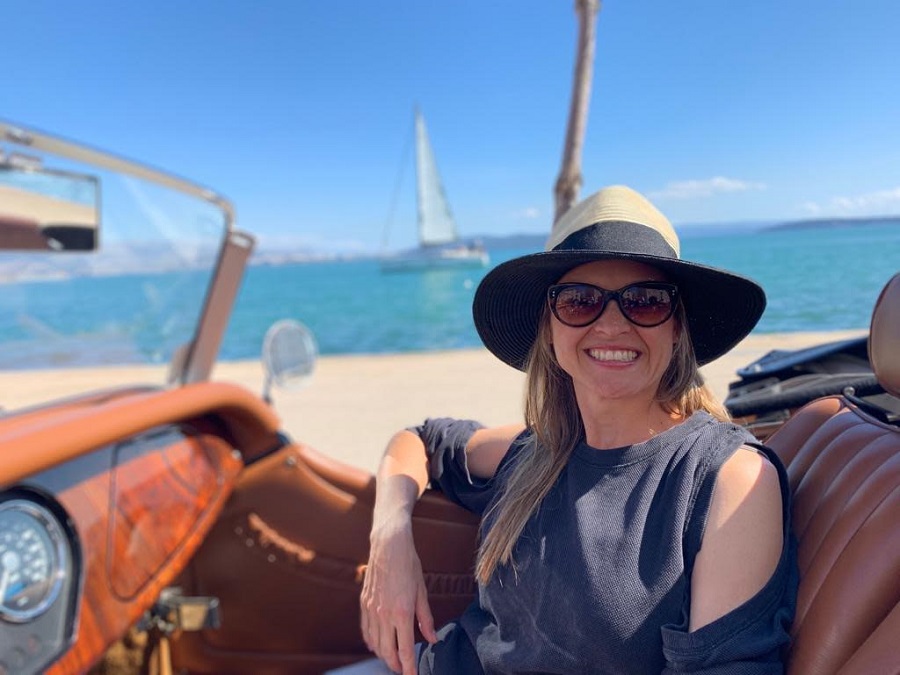
Saltwater started as a ‘side hustle’ to test and build the concept, which is a space to work, run business networking events and workshops. We’ve since had over 300 people pass through our doors - and more recently, were chosen to join the Split Croatian Chamber of Economy’s (HGK) incubator program for women entrepreneurs. This means we continue a slightly modified business as usual - while delivering projects I want to work on locally and in the Mediterranean.
We are soon delivering an EU Smart-Ag project. I also just returned from representing Croatia at a EUSAIR forum, for creative women-led businesses and the economic growth strategy for the Adriatic and Ionian region. There’s plenty of opportunities for Saltwater and our members, especially women, now we have the support of the HGK.
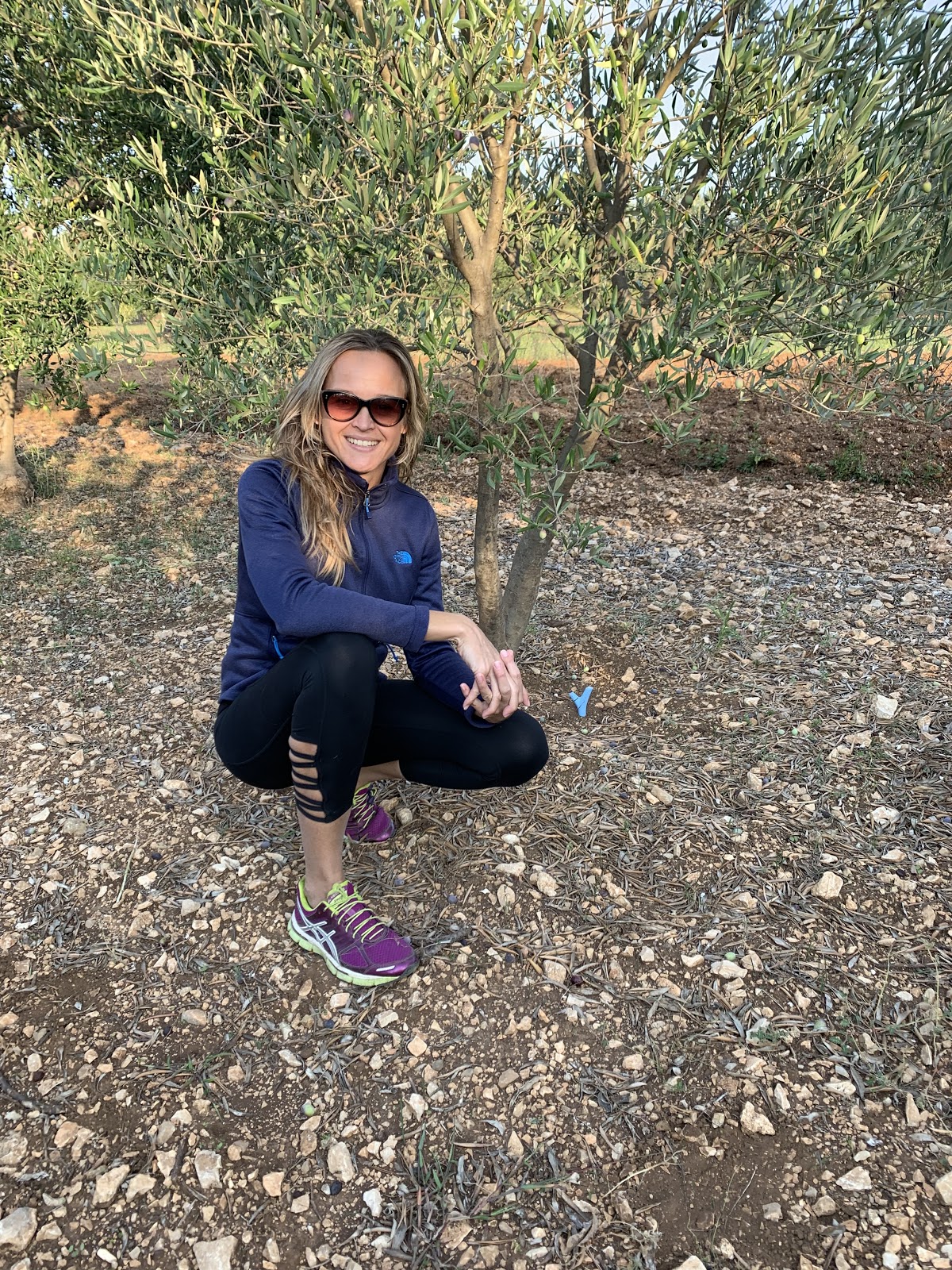
2. Looking back, what were your hopes, expectations, and fears about moving to Croatia?
To make it work here! To be collaborating with other forward-thinkers - people who also see the potential markets and opportunities here, and this has proved true.
No fear. As I mentioned, it was fairly low-risk for me, as my working arrangement enabled me to be here. Also, I have been coming here since childhood, so the ‘terrain’ and even mindset were familiar.
Admittedly, the first 2 years were tricky, with personal grief, greedy landlords, and my lifelong support network very far away. With the support of some incredible people I’ve met here, meditation, introspection - and being accepted into the HGK incubator, I’ve entered the 3rd year with a positive outlook and things have been going remarkably well.
I can at last say “I love it here” and more importantly, I’ve got this!
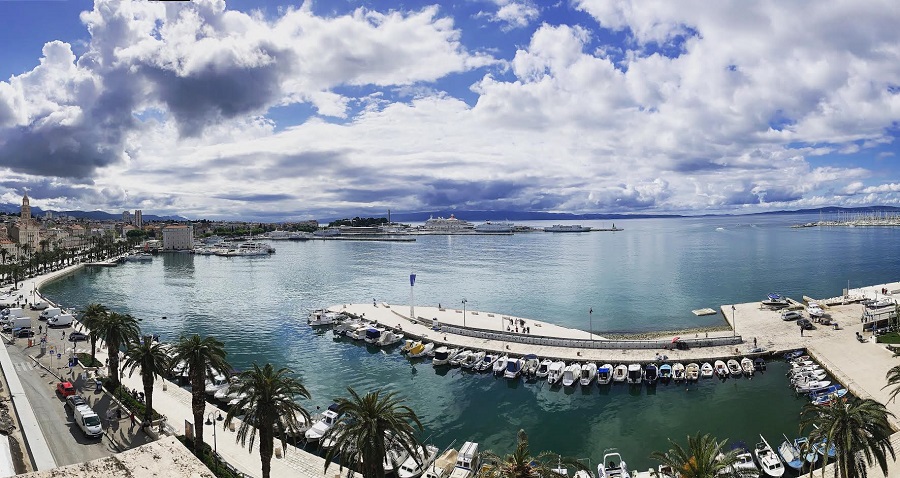
3. How supportive was your Croatian community back home at the time?
I would say secretly concerned, but certainly encouraging. It’s only a plane ticket back at the end of the day, isn’t it? Still, everyone’s heard horror stories. I had heard great things about the scene in Split, and undertook quite a bit of research and contacted people in advance. I also made a brief visit to Split in 2016, as I had only ever been here 1 night prior to picking it as a new home.
Like many Australian-born Croatians, and I imagine other diaspora around the world, my family upbringing was one of pride for this faraway homeland. Almost every other living relative I had was here. We did things differently to most other kids - language school, food, soccer, folk dancing, church. I apparently only spoke Croatian -- and fluently, until age 4. There was a certain mythology to this place and you were born into this struggle among a community who celebrated- and fought to assert, their identity. Being here now is like the sweet reward to a struggle you’ve participated in your entire life. I think that’s what people see when someone takes the leap to come here, so it is often supported, and lived through vicariously - not everyone can come here, for a number of reasons.
As a longtime traveller, I just view it like jetting off to live as an expat anywhere in the world - you can stay for a few years, or a few decades. Life can take you anywhere, so there really should be no fear, possibly it’s the pressure of ‘making it’ as there’s such an emotional connection when it comes to the ancestral ties here. I think the situation is different if you go to Singapore and return, compared to returning from say Split. It’s also part of the European Union, meaning your market is 500 million, not just 4 million. If you look at things this way, this is a perfect EU base if you can overcome the usual snags.
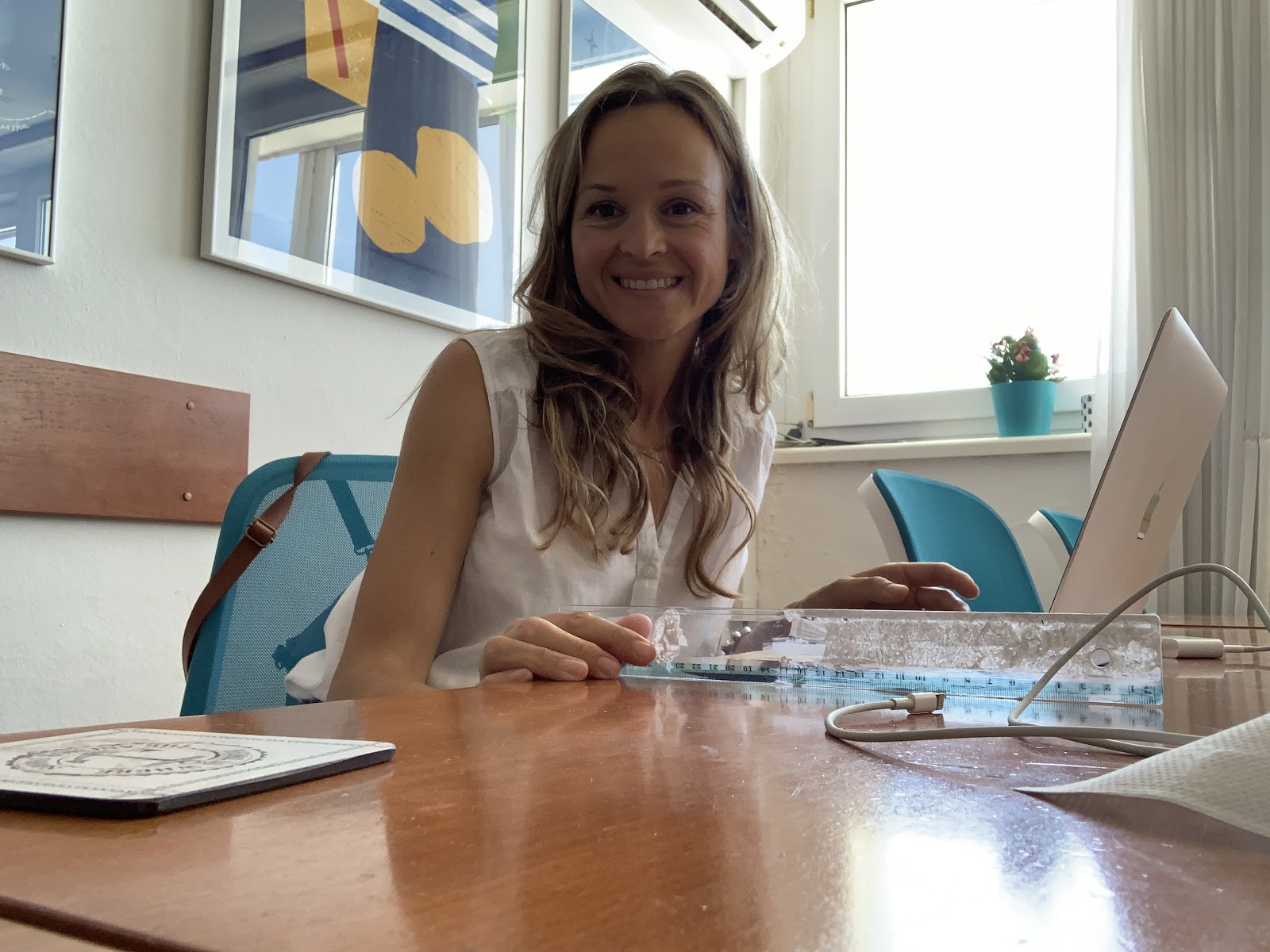
4. What were the main differences in what you expected to find in Croatia and the reality of living in Croatia?
The pace and living seasonally, i.e. in a tourist town. I had this romantic notion about living in the Med, and the frustrations of things being slow kicked in, but have passed. Even today, if I’m walking “too fast” for the locals I get a soft reminder to go “pomalo”. Which is great. It’s a reminder to be more present; poised. Coming from Canberra, I also didn’t realise what living in a tourist town would be like! It must seem to some we’re on a perpetual holiday, but there’s a cadence to the year, which is actually a beautiful thing if you embrace it. Even though the crowds, workers and temperatures reach boiling point by the end of Summer, living according to the seasons feels like you’re living a life much more in tune with nature - for me at least.
To mirror some of the other responses to this question, yes, the general expectation you will struggle with bureaucracy and encounter instances of personal greed. I am still
surprised by the passivity here and negativity of some people, the number of youth leaving - and no wonder, as there are very few role models or people encouraging you to stay. Also, the dumpster diving for bottles by people of all ages.
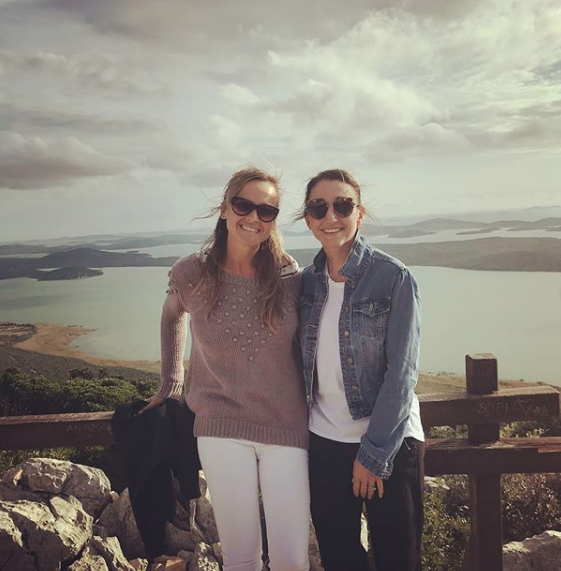
5. Many diaspora think of returning, but few do. In truth, there is little information out there about real-life stories and help/info about the process. What advice do you have for those who are thinking about making the move?
I can only speak from my experience. If your work or skills are portable:
⦁ Try being here for a good part of a year, including outside your usual time if that’s just been summer
⦁ Have at least some kernel of an idea of what you would do here, and begin researching and exploring this.
⦁ Connect with people in the field you would like to be in; ask them for insights.
⦁ Ask for help. Tell people what you’re looking for - I’ve found people are very helpful. Likewise, be willing to help in return in some way
⦁ Be open to something other than your original idea. Things will feel different when you’re on the ground, and opportunities always open up if you are receptive.
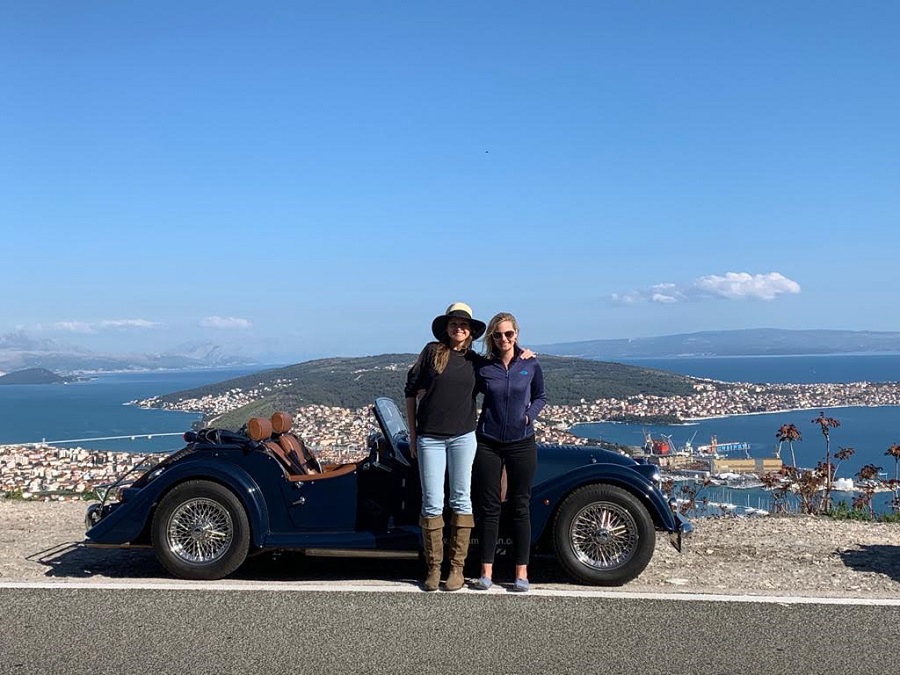
6. How were you perceived in Split as diaspora moving back - was the welcome warm?
The welcome has been warm as far as I’m aware. Family here have seen me longer than I’ve been before, and seen the business growth - so perhaps think it for real, for now! I am pleased to have made new friends and carry on as a regular member of society, albeit with an Australian accent when I speak Croatian. As a citizen, I have an equal legal right to be here as anyone else ‘from’ here, thus I expect to be treated the same as anyone else. It is clear I’m not from here, so I think the decision in their eyes affirms I consider Croatia better if I am here, so it is positive once the disbelief subsides. Living in both countries can be great. Right now, I prefer being by the sea and in the heart of Europe.
7. Through a lot of hard work, you have been very successful, while many foreigners have given up and left Croatia. What are the keys to success in doing business in Croatia in your opinion?
I am still progressing - I am still far from where I know I can be. The business is still young, and I am in it for the long haul. My version of success is measured by joy in what I do, life satisfaction and meeting the goals I’ve set thus far - in which case yes, I am succeeding.
The ways I have found useful are being patient, being part of your local community and respecting things are the way they are here for a reason. Also knowing who and what to filter out. When it comes to moving forward, a lot of doors here are open, i.e. unlocked. They can just be very heavy and may never have been opened before. So, if you can find a way around the inevitable negativity, and attitude things are impossible or ‘too hard’ then you can succeed here. Perseverance. And a really supportive circle around you; the people connected to Saltwater have helped me on every level imaginable.
8. What is the diaspora community like in Split and how integrated is it with locals?
The long-running Croatian Australian and Friends Society (HADIP) often organise events, and this has a blend of locals, diaspora and expats attend, so it really depends on personal preference when the community meets. I would say there is a balance, but usually more non-local born people attending these.
Being a tourist city, it feels like almost everyone is from somewhere else, so I don’t think about this much. Knowing both languages I probably slide into both categories easier, so again, it may not apply to me. I would say both sides get along - be it for business, or pleasure. It’s a matter of shared interests in the end.
9. And finally, a word on this conference. What are you hoping to get out of it?
I’m always interested in listening to other stories and meet people I will resonate with. Several themes in the conference interest me, so hopefully they are informative. There is more of a gender balance than when the event was first advertised, so I am hoping even more women attend or get inspired to invest or return here. My role as a panelist is to share the story of remote working and the projects we work on at Saltwater and the incubator. I hope our collective stories reach anyone considering moving, doing business or a project in Dalmatia, especially women who need support, or anyone curious about moving to Split.
Thanks for the opportunity to share this.
For the full programme at the 2nd International Conference on Diaspora Tourism (in English and Croatian), click here.
For more on the Croatian diaspora, check out the TCN dedicated section.


